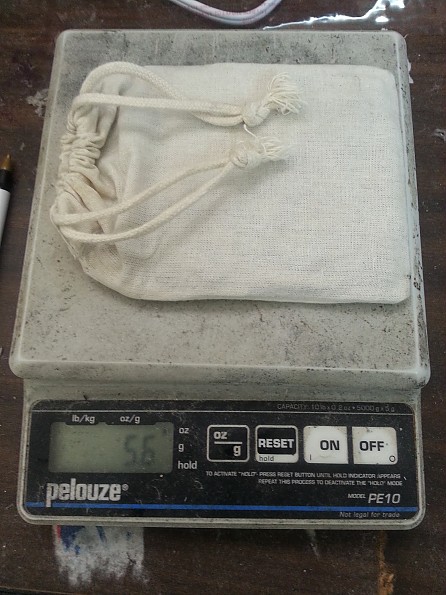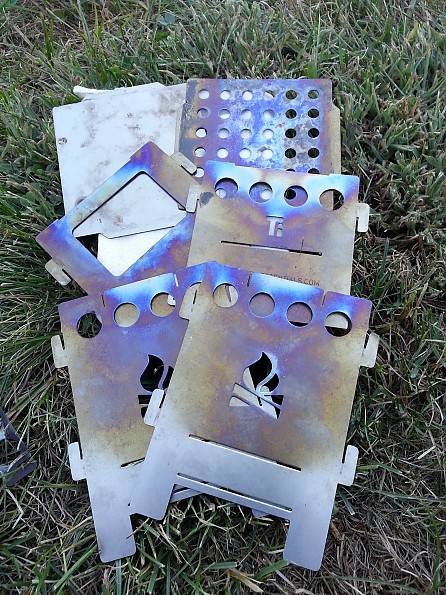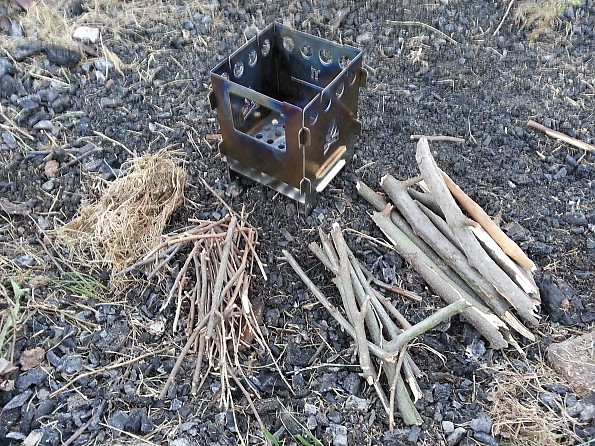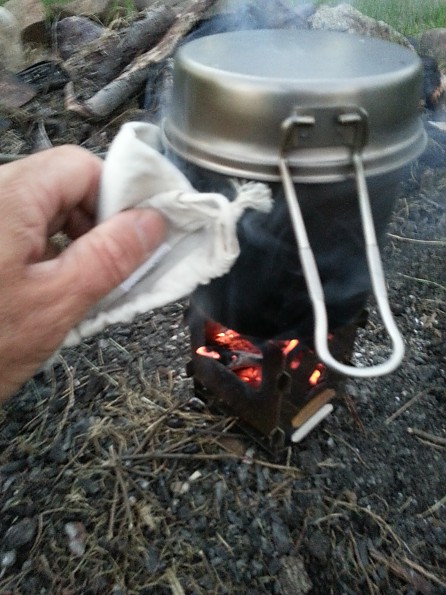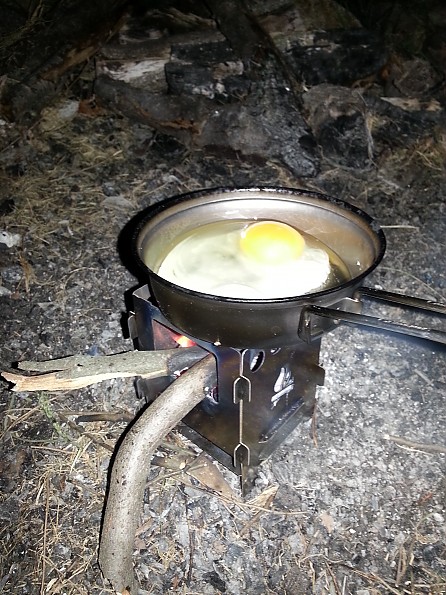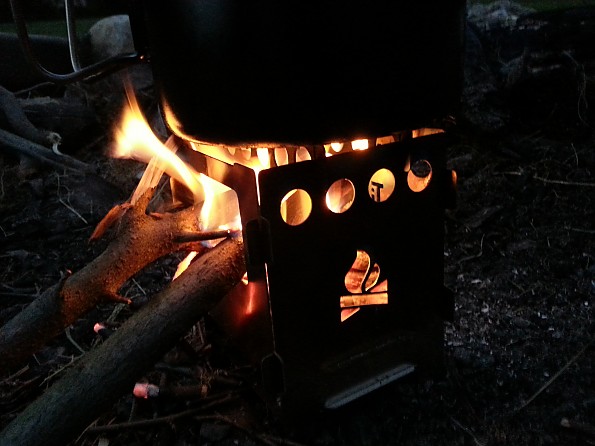Bushcraft Essentials Bushbox Titanium Outdoor Pocket Stove
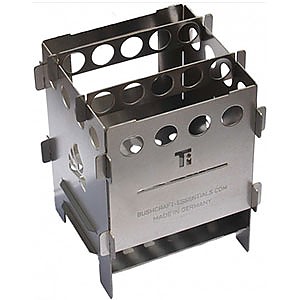
I recently purchased the Bushbox Outdoor Pocket Stove (titanium version) and found it to be a compact and versatile multi-fuel stove/stand that will likely become part of my go-to cooking system when I’m looking for something more than a hot cup of coffee.
It's designed primarily for bio-fuels (e.g. twigs) and can easily accommodate alcohol burners and solid fuel tablets. In this review, I field test the Bushbox as a twig stove, and as a stand for my Trangia alcohol burner, tea-light alcohol burner, and Esbit solid fuel tablets.
Pros
- Versatile
- Compact
- Stable
- High-quality
Cons
- Pricey if you’re thinking of this as “just” a pot stand
- Not the lightest pick of the bunch
- Twig stoves are sooty when compared to other fuels
I chose the Bushbox over its competitors based on its overall compact design and versatility through its ability to accommodate alcohol and solid fuels when wood burning is not an option.
Specs:
Weight: 5.6 oz., including the cotton storage bag
Dimensions: 4.7" x 3.6" x 3.6" (packs flat)
In the Field:
Assembly was a snap (pun intended)! The sides lock into place by a raised nub (circled below) which made the stand very stable for its compact size. I’ve read online that some people had difficulty disassembling the unit but I believe you’ll have no problem as long as you remember to pull the sides out slightly to clear the raised nubs as you slide the side wall up and out of the slotted tabs.
With the unit fully assembled, I set out to build a fire in the Bushbox the same way I would any other fire…by gathering enough tinder, twigs, and fuel to start the fire and keep it going for the intended length of time.
Two trivets are included with the Bushbox, which can be set flush with the main body of the stove or raised up slightly from the main body to allow more airflow while the cookpot is on the stove. I chose to leave the trivets out while building the fire so I could build a bed of embers as quickly as possible before adding larger sticks, then I placed the trivets in the raised position for cooking.
I was able to feed larger sticks into the fire from the side after the fire burned down to a nice bed of embers, although I had to stoke the fire to keep it going by removing the cookpot and blowing on the fire from time to time.
I’ll take this opportunity to say that I didn’t have a good first impression of the included cotton pouch and I could see myself tossing it in the trash after finding a more suitable carrying case. However, in the field I found it to be very useful as a pot grabber! I typically use a bandana as a pot grabber but the cotton pouch was handy at the time and, I have to admit, it worked very nicely! It was thick enough to protect my hand from the heat and I didn’t have to concern myself with it dangling into the flame the way I would’ve using a bandana. So, the multi-functional cotton pouch stays!
I use filtered water to prepare my backcountry meals so there’s no need for me to heat the water to a rolling boil. The water is hot enough for me at a simmer. The twig fire was less efficient than my alcohol or solid-fuel stoves, simmering 2 cups of water in about 7.5 minutes not including the 10 minutes it took me to build the fire. That’s a snail’s pace compared to a 3.5 minute simmer with alcohol burners and solid fuel tablets, but no reflection on the Bushbox, just the nature of the heat generated by burning wood as opposed to other fuels.
On my backpacking trips, I typically leave the cooking at home and simply heat water on the trail for re-hydrating meals, coffee, and hot chocolate. But, I thought I would try to cook an egg over the twig stove to round out my review and in case the urge ever strikes me to cook in the field. The egg cooked surprisingly even over the flames, although I had to lift the pan off the stove a few times to help control the heat.
Word of caution: this stove will not improve your cooking skills! I tried to “Bobby Flay” the egg by flipping it in the pan without a utensil and…well…the egg landed yolk down in the dirt! That’s bad for me but fortunate for the resident groundhog. I was saying “damn!” as the egg hit the ground, but I think I heard a faint “yes!” from the nearby groundhog hole.
Using the Bushbox with an alcohol burner (e.g. Trangia), there are two alternatives. First, you could remove the trivets and drop the burner in from top, or second, you could remove the front wall and slide the burner in from the front. Sliding it in from the front has its advantage in that you can also use the burner’s snuffer ring.
In the pictures below I used the Trangia burner cap to slightly elevate the burner (be sure to remove the o-ring!) and get it closer to the cookpot. I had to remove the front trivet with my multi-tool pliers (hot!) to slide the snuffer ring into place from this raised position. I later discovered that placing the burner directly on the Bushbox upper tray heated the water just as fast and it also allowed me to slip the simmer ring on the burner without removing the trivet. I’ll definitely place the Trangia burner directly on the tray next time.
The Bushbox is less stable with one wall removed but it became sufficiently stable after putting the trivets back in place.
Assembling the Bushbox with the upper tray in the higher position (pictured below) allows you to use a smaller heating source such as a tea-light alcohol burner or a solid fuel tablet (Esbit shown). No surprises here in that my simmer times were comparable to similar heat sources using other pot stands—about 3.5 minutes. The outdoor temperatures were in the lower 80s and there was a slight breeze which could be seen pushing the flame around a bit.
Conclusion:
Using the Bushbox as a twig stove definitely has its drawbacks in terms of cleanliness and ease of use. The fire took time to build, required babysitting, and left a sooty residue on the Bushbox and my cookpot. Perhaps the excess residue was due to the type of wood I used. The residue was simple enough to clean up but it left some discolored areas on both the cookpot and the stand, which I happen to think adds character.
As I mentioned at the top of this review, this great little Bushbox will likely become my go-to stove/burner stand based on its overall versatility alone. I love the idea of leaving fuel behind in areas that allow bio-fuel fires, and the simplicity of carrying a single stove/stand setup along with a few solid fuel tablets as backup rather than an entire backup stove.
Although the twig stove requires more work and cleanup compared to alcohol or solid fuel tablets, I think it’s a great addition to my cooking gear both as a twig stove and as a stand for other burners/fuels…and ya gotta love the ambiance! Marshmallows anyone?
Source: bought it new
Price Paid: $49.90
Your Review
Where to Buy
You May Like
Specs
| Price |
MSRP: $56.10 Reviewers Paid: $49.90 |
| Weight |
160 g |
| Dimensions |
11.5 x 9 x 0.5 cm |


